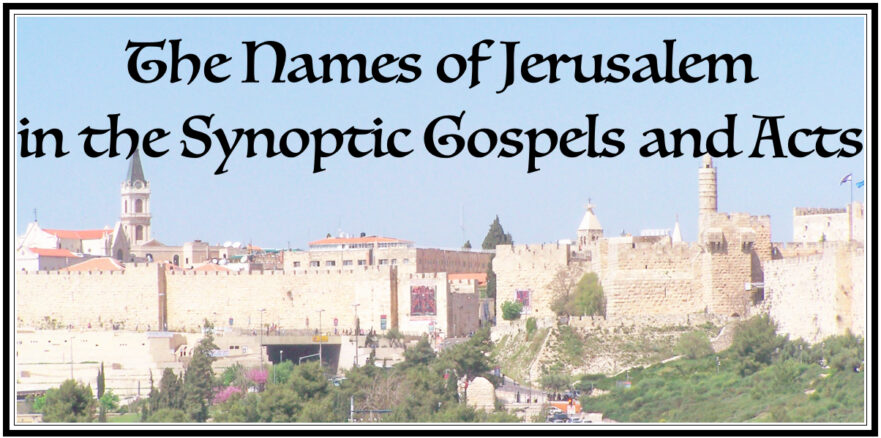How to cite this article: JP Staff Writer, “The Names of Jerusalem in the Synoptic Gospels and Acts,” Jerusalem Perspective (2023) [https://www.jerusalemperspective.com/26856/].
There are two main designations for the spiritual center of the Jewish world in the Synoptic Gospels and Acts;[1] these are Ἱεροσόλυμα (Hierosolūma) and Ἰερουσαλήμ (Ierousalēm).
Ἱεροσόλυμα (Hierosolūma) is an adaptation of the name “Jerusalem” to Greek style. This form of the name, which suggests to Greek speakers the meaning “holy Salem,”[2] hinted at the sanctity of the city and sounded less foreign to the Greek ear than Ἰερουσαλήμ (Ierousalēm),[3] the other form of “Jerusalem” we encounter in the Synoptic Gospels and in Acts.
Ἰερουσαλήμ (Ierousalēm) is a straightforward transliteration of the Hebrew name יְרוּשָׁלֵם (yerūshālēm), the ancient vocalization of ירושלם,[4] which later came to be pronounced as יְרוּשָׁלִַם (yerūshālaim) with a dual ending. The transition between the older and more recent vocalizations of ירושלם is already attested in the later books of the Hebrew Scriptures, where we find a few instances of the spelling ירושלים (with a yod before the final mem) in the Masoretic Text (MT).[5] The more recent vocalization with the dual ending is also attested in the Dead Sea Scrolls (DSS).[6] Both the more ancient and the more recent vocalizations appear to have been current in the Hebrew spoken in the first century C.E.[7]
From what we have learned about the two names already, it should come as no surprise to discover that Greek writers, both Jewish and non-Jewish, generally preferred the Hellenized form of “Jerusalem,” Ἱεροσόλυμα (Hierosolūma), whereas Ἰερουσαλήμ (Ierousalēm) is the form that tends to occur in writings translated from Hebrew originals.[8] Thus, Ἰερουσαλήμ (Ierousalēm) is the dominant form in the Septuagint (LXX),[9] but Ἱεροσόλυμα (Hierosolūma) is the form writers such as Philo[10] and Josephus used regularly.[11]
Given these preferences it is reasonable to suppose that the uses of the two Greek forms of “Jerusalem” in the Synoptic Gospels could tell us something about the sources upon which they are based or about the audiences for which the Gospels were composed. If, for example, the transliterated form of “Jerusalem” dominates, this might be taken as evidence in support of the theory that the canonical Greek Gospels were originally composed in Hebrew (or Aramaic). On the other hand, if the Hellenized form of “Jerusalem” were found to predominate, this could be cited as evidence to refute this theory.
Paid Content
Premium Members and Friends of JP must be logged in to access this content: Login
If you do not have a paid subscription, please consider registering as a Premium Member starting at $10/month (paid monthly) or only $5/month (paid annually): Register
One Time Purchase Rather Than Membership
Rather than purchasing a membership subscription, you may purchase access to this single page for $1.99 USD. To purchase access we strongly encourage users to first register for a free account with JP (Register), which will make the process of accessing your purchase much simpler. Once you have registered you may login and purchase access to this page at this link:
JP wishes to thank Georgia Clifton for her comments on this article prior to its publication.
- [1] In addition, the Gospel of Matthew twice refers to Jerusalem not by name but as ἡ ἁγία πόλις (hē hagia polis, “the holy city”; Matt. 4:5; 27:53). Matthew’s term corresponds to עִיר הַקֹּדֶשׁ (‘ir haqodesh, “the city of holiness”) in Hebrew, an appellation of Jerusalem already attested in the Hebrew Scriptures (Isa. 48:2; 52:1; Neh. 11:1, 18). The LXX translators rendered עִיר הַקֹּדֶשׁ as (ἡ) πόλις (ἡ) ἁγία ([hē] polis [hē] hagia, “[the] holy city”). Matthew’s word order, ἡ ἁγία πόλις, which differs from LXX, is un-Hebraic. Both instances of “holy city” in Matthew’s Gospel are probably the product of Matthean redaction. ↩
- [2] See Henry J. Cadbury, The Making of Luke-Acts (London: SPCK, 1927; repr. Peabody, Mass.: Hendrickson, 1999), 227; James A. Montgomery, “Paronomasias on the Name Jerusalem,” Journal of Biblical Literature 49.3 (1939): 277-282, esp. 280; Joachim Jeremias, “ΙΕΡΟΥΣΑΛΗΜ/ΙΕΡΟΣΟΛΥΜΑ,” Zeitschrift für die neutestamentliche Wissenschaft 65.3/4 (1974): 273-276, esp. 274 (for an English translation of Jeremias’ article on the WholeStones website, click here). Salem is the name of the city where, according to Gen. 14:18, Melchizedek reigned in the time of Abraham. ↩
- [3] Clearchus of Soli (ca. 300 B.C.E.), quoted by Josephus in Against Apion 1:179, commented on the foreignness of Jerusalem’s name, which he gave as Ἰερουσαλήμη (Ierousalēmē), a slight variation of the transliterated form Ἰερουσαλήμ (Ierousalēm). ↩
- [4] On יְרוּשָׁלֵם as the more ancient pronunciation, see George Adam Smith, “The Name Jerusalem and its History,” in his Jerusalem: The Topography, Economics, and History from Earliest Times to A.D. 70 (2 vols.; London: Hodder and Stoughton, 1907-1908), 1:250-265, esp. 252; Avi Hurvitz, A Concise Lexicon of Late Biblical Hebrew Linguistic Innovations in the Writings of the Second Temple Period (Leiden: Brill, 2014), 127-129. ↩
- [5] The spelling יְרוּשָׁלַיִם (with a yod before the final mem) occurs in Jer. 26:18; Esth. 2:6; 1 Chr. 3:5; 2 Chr. 25:1; 32:9. See Eduard Yechezkel Kutscher, A History of the Hebrew Language (ed. Raphael Kutscher; 2d ed.; Jerusalem: Magnes; Leiden: Brill, 1984), 81 §118, 94 §153; Hurvitz, A Concise Lexicon of Late Biblical Hebrew Linguistic Innovations in the Writings of the Second Temple Period, 128. ↩
- [6] In DSS the spelling ירושלים is common (cf., e.g., 1QM I, 3; III, 11; VII, 4; XII, 13, 17). ↩
- [7] For this reason both Hebrew spellings of “Jerusalem”—with and without the second yod—occur on coins from the first Jewish revolt against Rome in 66-73 C.E. See Hurvitz, A Concise Lexicon of Late Biblical Hebrew Linguistic Innovations in the Writings of the Second Temple Period, 128. ↩
- [8] However, the Hellenized form Ἱεροσόλυμα occurs a few times in 1 Maccabees, which was translated into Greek from Hebrew. Nevertheless, in 1 Maccabees the transliterated form dominates. On the other hand, the Hellenized form dominates in Greek Tobit although this book was composed either in Hebrew or Aramaic. Both Hebrew and Aramaic fragments of Tobit were discovered among DSS. ↩
- [9] See Edwin Hatch and Henry A. Redpath, A Concordance to the Septuagint and the Other Greek Versions of the Old Testament (Including the Apocryphal Books) (3 vols.; Oxford: Clarendon, 1897; repr., 2 vols.; Grand Rapids: Baker, 1983), 3:81. ↩
- [10] See Peder Borgen, Kåre Fuglseth and Roald Skarsten, The Philo Index: A Complete Greek Word Index to the Writings of Philo of Alexandria (Grand Rapids: Eerdmans; Leiden: Brill, 2000), 177. In Philo’s works the transliterated spelling Ἰερουσαλήμ occurs only once (Somn. 2:250), and in that context Philo took care to explain that Jerusalem is called Ἰερουσαλήμ “by the Hebrews” (ὑπὸ Ἑβραίων). ↩
- [11] See Karl Heinrich Rengstorff, ed., A Complete Concordance to Flavius Josephus: Unabridged Study Edition (2 vols.; Leiden: Brill, 2002), 2:2151-2152. ↩































































































